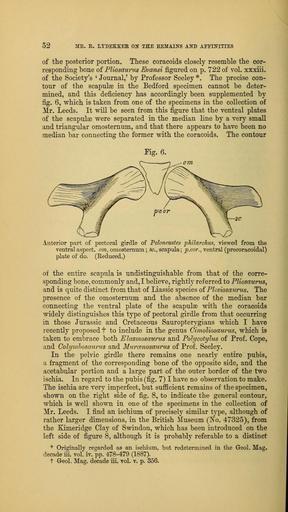MAKE A MEME
View Large Image

| View Original: | The_Quarterly_journal_of_the_Geological_Society_of_London_(13936901182).jpg (1182x2101) | |||
| Download: | Original | Medium | Small | Thumb |
| Courtesy of: | commons.wikimedia.org | More Like This | ||
| Keywords: The Quarterly journal of the Geological Society of London (13936901182).jpg ¢54 1TR E LYDEKKER ON THE REMAINS AND AEEINITIES <br> form it remains to consider its generic position At the time <br> when I first brought the subject of this part of my paper under the <br> Society's notice I was inclined provisionally to employ the term <br> Plesiosaurus in the wide sense in which it has been used by Mr <br> Hulke Subsequent experience has however led me to the con- <br> clusion that it is advisable to separate from that genus not only those <br> Post-Liassic forms which I have already incidentally mentioned under <br> the name of Cirnoliosaurus but also the present species and certain <br> kindred forms I shall confine then the name Plesiosaurus to <br> those Sauropterygians having a neck of considerable length compa- <br> ratively small heads and teeth the cervical vertebras more or less <br> elongated and usually with double costal facets and firmly anchylosed <br> arches and the pectoral girdle with a comparatively large omosternum <br> Fig 9 <br> Part of pectoral limb of Peloneustes philarchus About £ <br> fe humerus ; t radius ; / ulna ; t\ radiale ; i intermedium ; /' ulna e <br> formed of two elements ; the scapulae being widely separated in the <br> ventral middle line with a small and concave ventral surface and a <br> very large dorsal portion extending throughout the length of the bone <br> and no median union between their ventral portion and the coracoids <br> In those forms which I propose to include in Cimoliosaurus the <br> neck is usually greatly elongated; the head and teeth are very <br> small ; the cervical vertebras are more or less elongated with single <br> costal facets and often complete anchylosis of the arches and ribs <br> with the centra ; while the pectoral girdle is devoid of an omoster- <br> num and has the ventral part of the scapulae very large and flat <br> and the dorsal part greatly reduced in size the ventral plates <br> meeting in the median line and sending down a median bar to join <br> the coracoids which are produced in the middle in advance of the <br> glenoid cavity This genus I regard as a branch in one direction <br> from Plesiosaurus while another branch has culminated in Plio- <br> saurus In the latter branch I would place the so-called Plesio- 36939833 113696 51125 Page 52 Text 45 http //www biodiversitylibrary org/page/36939833 1889 Geological Society of London NameFound Cimoliosaurus NameConfirmed Cimoliosaurus NameBankID 4116783 NameFound Peloneustes philarchus NameConfirmed Peloneustes philarchus EOLID 4532441 NameBankID 6049867 NameFound Plesiosaurus NameConfirmed Plesiosaurus EOLID 4532515 NameBankID 4302234 Biodiversity Heritage Library The Quarterly journal of the Geological Society of London v 45 1889 Geology Periodicals Smithsonian Libraries bhl page 36939833 dc identifier http //biodiversitylibrary org/page/36939833 smithsonian libraries Information field Flickr posted date ISOdate 2014-04-21 Check categories 2015 August 26 CC-BY-2 0 BioDivLibrary https //flickr com/photos/61021753 N02/13936901182 2015-08-26 06 56 31 cc-by-2 0 PD-old-70-1923 The Quarterly journal of the Geological Society of London 1889 Photos uploaded from Flickr by Fæ using a script | ||||